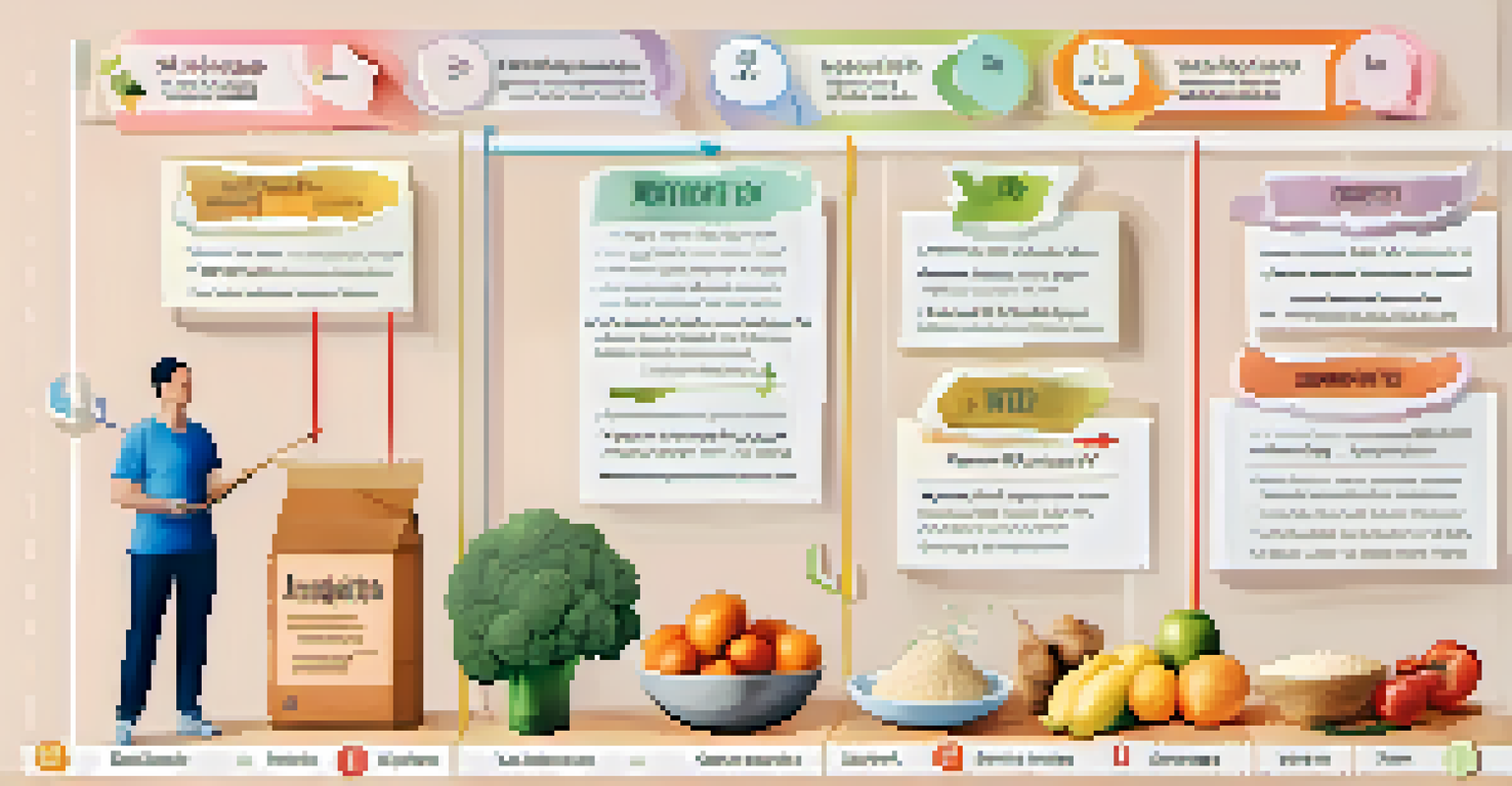Understanding Food Labels: Making Informed Choices

Why Food Labels Matter for Health and Nutrition
Food labels serve as a crucial tool in helping consumers make informed dietary choices. They provide essential information about the nutritional content and ingredients of the products we consume daily. Understanding these labels can lead to healthier eating habits and ultimately improve your overall well-being.
You are what you eat, so don't be fast, cheap, easy, or fake.
In a world filled with processed foods, knowing how to interpret food labels can empower you to choose options that align with your health goals. For instance, a quick glance at the label can reveal whether a product is high in sugars or unhealthy fats, which is vital for maintaining a balanced diet. It’s like having a map that guides you through the often confusing grocery store aisles.
Moreover, food labels can help identify allergens or additives that might not be suitable for certain individuals. Whether you're avoiding gluten or keeping an eye on sodium intake, understanding labels enables you to navigate your dietary restrictions with confidence.
Decoding the Nutrition Facts Panel
The Nutrition Facts panel is your best friend when it comes to understanding what you're eating. It typically lists calories, serving size, and key nutrients like fats, carbohydrates, and proteins. By familiarizing yourself with this panel, you can easily compare products and make healthier selections.

For example, if you're trying to cut down on sugar, the Nutrition Facts panel allows you to spot added sugars versus natural sugars. This insight can help you choose a yogurt with less sugar, making a significant difference in your daily intake. Think of it as a cheat sheet that highlights the best options for your health.
Food Labels Enhance Healthy Choices
Understanding food labels empowers consumers to make informed dietary decisions that support their health goals.
Additionally, the serving size is crucial; it's easy to overlook how many servings are in a package. A snack that seems low in calories can quickly become high-calorie if you eat multiple servings, so be mindful of this detail when making choices.
Understanding Ingredients Lists: What's Really Inside?
Ingredients lists can feel daunting, but they hold the key to understanding what’s actually in your food. Ingredients are listed in descending order by weight, meaning the first few items make up the bulk of the product. This can help you identify the main components and whether they align with your dietary preferences.
In the end, the goal is not to eat less, but to eat right.
For instance, if you see 'whole grain' listed as the first ingredient in bread, that’s a good sign you’re choosing a healthier option. Conversely, if sugar or artificial additives top the list, it might be time to reconsider. Think of it as a sneak peek into the product's true nature.
Moreover, being aware of certain terms like 'organic' or 'natural' can help you make better choices. While these labels sound appealing, they can sometimes be misleading. Understanding the ingredients can help you navigate this marketing jargon more effectively.
Identifying Health Claims: What Do They Really Mean?
Health claims on food products can be enticing, but they often require a closer look. Terms like 'low-fat,' 'heart-healthy,' or 'sugar-free' can create a misconception that a product is healthier than it truly is. Always check the Nutrition Facts panel and ingredients list for a complete picture.
For example, a 'low-fat' yogurt might have added sugars to compensate for flavor, which could negate its health benefits. It’s essential to be a savvy shopper and not take these claims at face value. Think of it like a relationship; you need to dig deeper to really know what’s going on.
Nutrition Facts Panel is Key
The Nutrition Facts panel allows for easy comparison of products, helping to identify healthier options based on key nutrients.
Additionally, some claims might pertain to specific nutrients, while others may be based on a general perception of healthiness. Understanding these nuances can help you avoid falling for marketing tricks and make more informed choices.
The Importance of Serving Sizes in Food Choices
Serving sizes are not just numbers; they play a pivotal role in how we interpret food labels. They tell us the portion of food that the nutrition information is based on, which is crucial for managing caloric intake. Without understanding serving sizes, it’s easy to misjudge how much you’re actually eating.
For instance, if a bag of chips lists a serving size of 10 chips but you eat 30, you're consuming three times the calories and fat than you initially thought. This can quickly derail your healthy eating plans. It's like trying to run a race without knowing the distance; you could end up way off track.
Being mindful of serving sizes not only aids in portion control but also helps with meal planning. By understanding how much of a product constitutes a serving, you can better assess how it fits into your overall diet.
Navigating Allergens and Special Dietary Needs
For individuals with food allergies or specific dietary requirements, food labels are lifesavers. Most labels now highlight common allergens such as nuts, dairy, gluten, and soy, making it easier to avoid harmful ingredients. This transparency allows consumers to shop with confidence, knowing they’re making safe choices.
For example, if you have a nut allergy, looking for a 'may contain' warning on a label can save you from a potential emergency. This kind of information helps you become more proactive about your food choices and can significantly enhance your dining experience.
Serving Sizes Matter
Being aware of serving sizes is crucial for managing caloric intake and ensuring accurate portion control.
Additionally, many brands now cater to specific dietary lifestyles like vegan or keto, clearly labeling their products. This helps you quickly find options that align with your eating preferences, making grocery shopping a breeze.
Tips for Making Informed Food Choices
Making informed food choices involves a combination of reading labels and understanding your personal health goals. Start by setting specific dietary objectives, whether it’s reducing sugar intake or increasing fiber consumption. This focus helps you filter through the vast number of options at the store.
Next, practice comparing similar products side by side. Look for differences in calories, fats, sugars, and serving sizes. This comparison can be eye-opening and often reveals healthier alternatives you might not have considered, similar to trying on different outfits before a big event.

Lastly, don’t hesitate to educate yourself further about nutrition. Resources like dietitians, nutrition books, or reputable websites can provide deeper insights, enabling you to navigate food labels with ease and confidence.